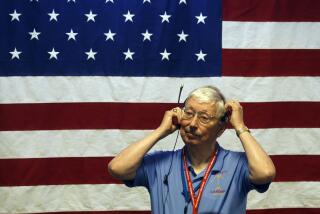Carl Sagan Made Contact With Us
The Pathfinder spacecraft that took us back to Mars for the first time in 21 years has been renamed in honor of the late astronomer Carl Sagan, but it ought to carry this warning:
Enter at your own risk.
No other scientist of his generation--possibly any generation--mastered the art of telling the public what science is all about as well as Sagan. His early PBS program, “Cosmos,” was the most-watched series in public television history. More than 500 million people in 60 countries saw it. He published more than 600 professional papers and wrote or edited more than 20 books.
All that brought him fame and fortune, to be sure, but something else as well. His enormous success, coupled with a personal demeanor that some found highly arrogant, also brought jealousy and criticism. Some accused him of abandoning a brilliant career to become a “popularizer” of science.
That’s an odd cross to bear for a man who understood better than most scientists that public support, including financing, of their work depends largely on their ability to sell their product to the rest of us. The proof is in the Pathfinder mission and the public’s fascination with that achievement. Does anyone think the National Aeronautics and Space Administration will have trouble getting the funding for its next robotic expedition to Mars?
The harshest criticism of Sagan, who died last year of cancer, came from within the scientific community itself, and that speaks volumes about how much scientists need to learn about the real world.
Despite the fact that he expanded the field of planetary physics, Sagan was rebuffed by the country’s most exclusive club of scientists, the National Academy of Sciences.
Sagan, whose last book is called “The Demon-Haunted World,” certainly had a few demons of his own that undoubtedly contributed to the hostility. With an astronomical ego, he sometimes dismissed those with whom he disagreed as though they had just crawled out from under a rock.
“Carl did not suffer fools easily,” one longtime associate said.
Added another friend, whom Sagan had chastised for interrupting his preparation for a television interview: “He had a supreme ego.”
My suspicion is he made one serious error in his attempts to bring the rest of us into his world: He was too successful.
There is an unspoken rule in the scientific community that goes something like this: Science should stand on its own merits, not on the ability of the scientist to express his work in glowing terms. The line between explanation and hype is a very fine line, indeed.
But my guess is that there is more to the problem than that. Scientists abhor the oversimplification that is required to make sense of their work to a general audience. A good scientist finds beauty in the preciseness of a mathematical formula. A layperson finds it intimidating and meaningless.
To those of us who try to bridge that gap, there is a compelling need to be fair to the science and comprehensible to the reader. To the scientists, there is a need to recognize that a general understanding of their work is better than none at all.
And there is change in the air. Scientists, facing the most severe budgetary crisis in decades, are becoming more vocal, urged on by such prestigious institutions as the National Science Foundation.
Most scientists think it’s OK to explain their work, and many believe scientists themselves must lead the way if we are ever going to reduce science illiteracy in this country. As a science writer, I rarely have problems getting them to talk. Sometimes, it’s harder to get them to stop.
Who would have wanted to make Carl Sagan stop talking?
The movie based on his best-selling novel, “Contact,” is playing across the country. And a robot is exploring Mars, something he long advocated during his career. He would have loved it.
He played a leading role in NASA’s Mariner, Viking, Voyager and Galileo missions to other planets. And now the Pathfinder has been renamed the Carl Sagan Memorial Station.
Decades from now--and my guess is it will be at least that long--humans will probably walk across the red, dusty soil of that planet.
Perhaps they will pause and attach a new nameplate to a relic from our age. Hopefully, it will say something like “Carl Sagan was here.”
*
Lee Dye can be reached via e-mail at [email protected]






